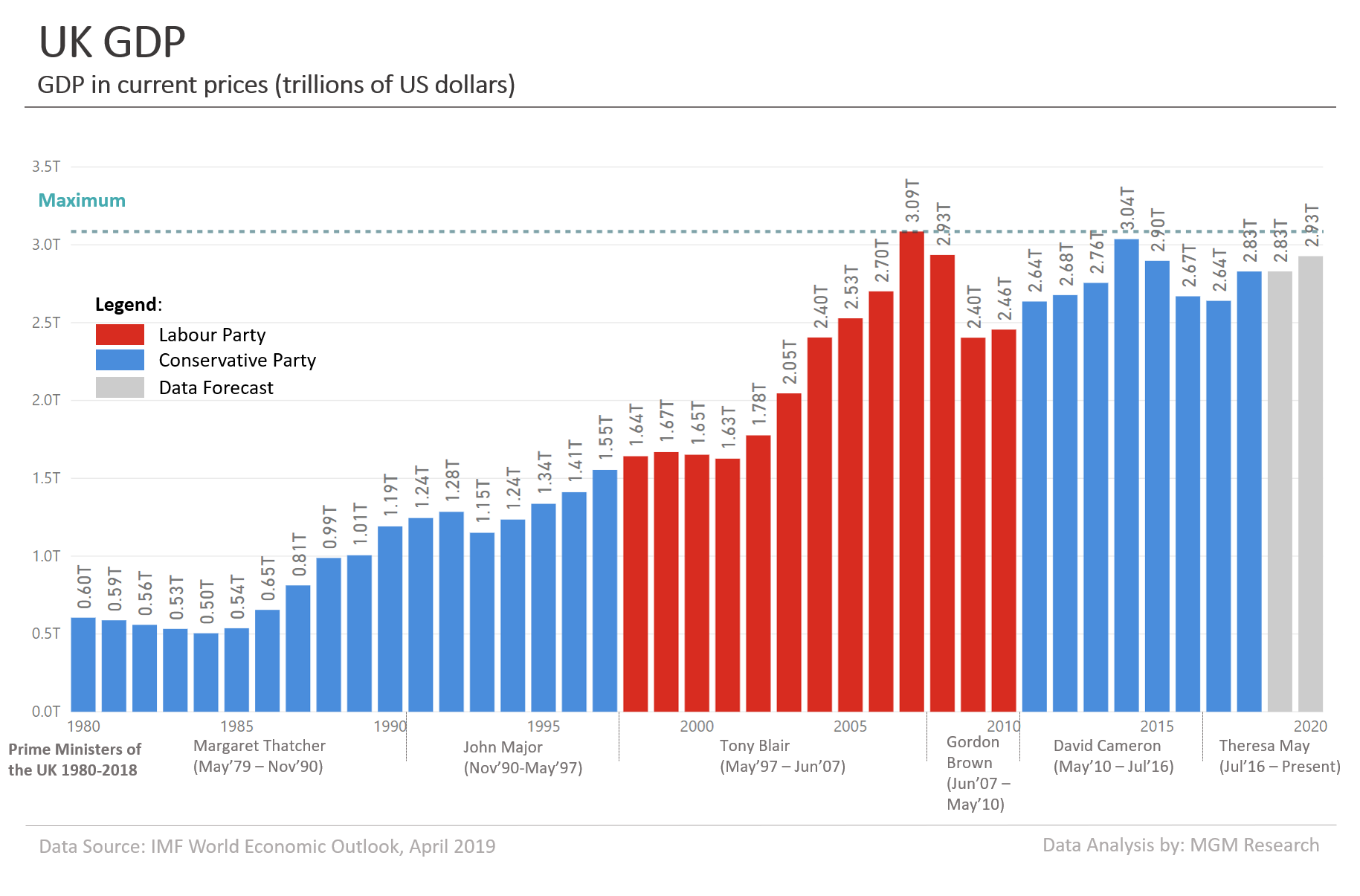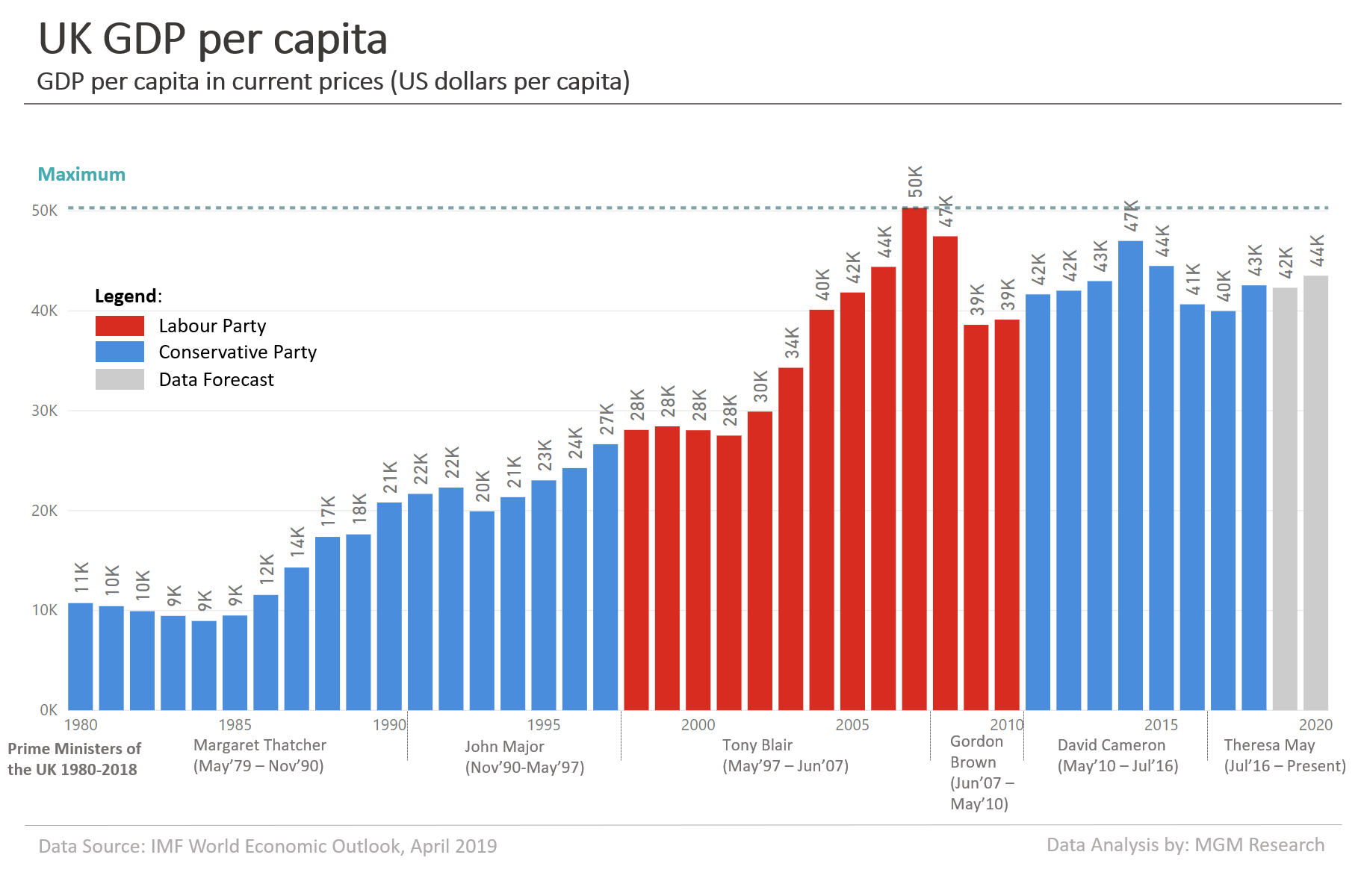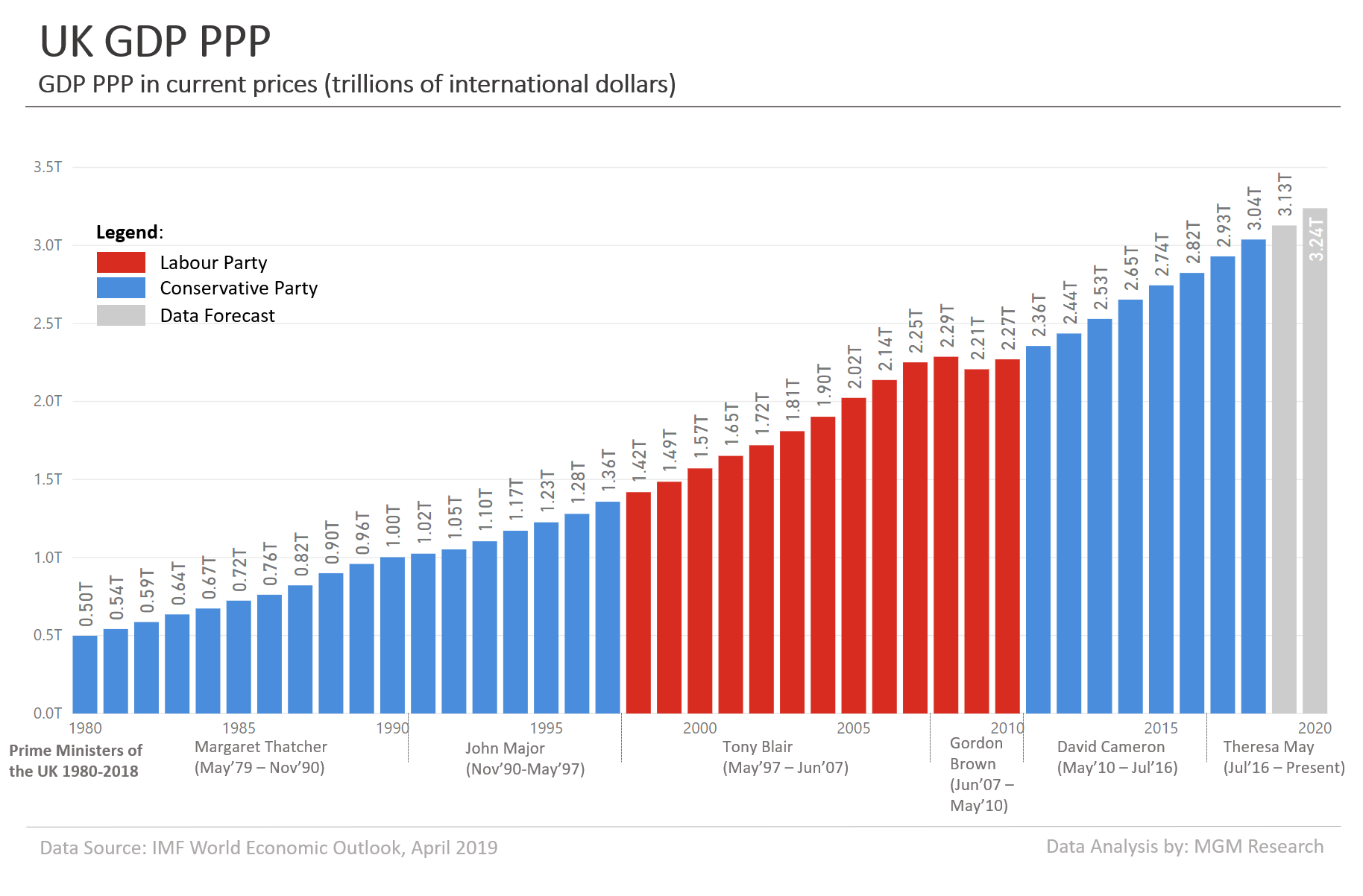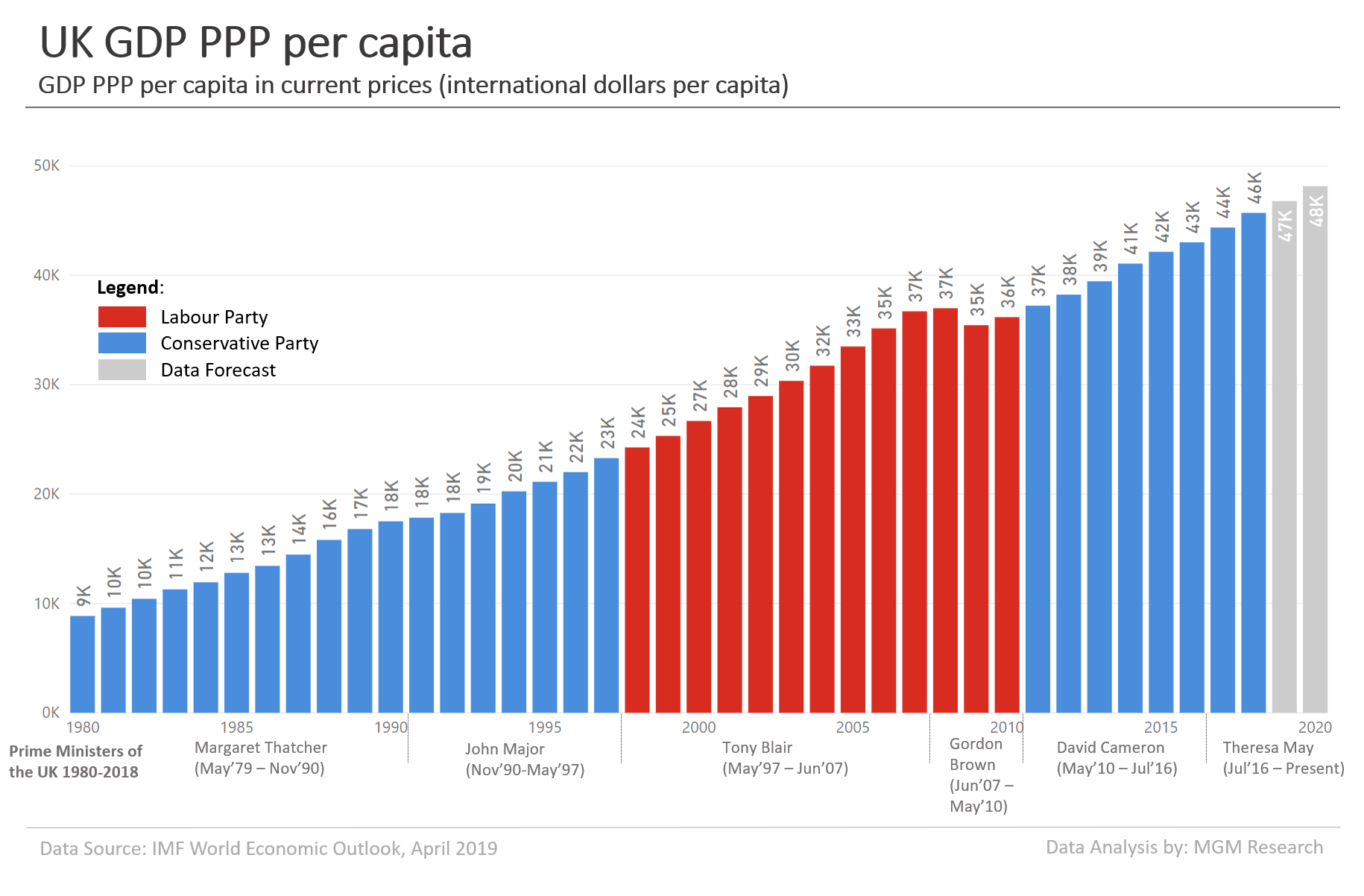In this article, we will share the charts and data for the Gross Domestic Product (GDP) related indicators of the United Kingdom (UK). We will provide the charts and data for Nominal GDP, Nominal GDP per capita, GDP on a Purchasing Power Parity (PPP) basis, GDP PPP per capita, and Real GDP Growth. We will present the charts and data for these indicators during the 40-year period from 1980 to 2020. We have used the publicly available data from International Monetary Fund (IMF). The data for 2019 and 2020 are estimates by IMF staff.
To make the charts little interesting, we have added the information about the parties leading the governments during the different time periods. We have also provided the information about the prime ministers of the UK from 1980 to 2018. This can help us relate the GDP indicator data during a particular time period with the party leading the government and its leader. The table below provides information on the prime ministers of the UK from 1980 to 2018, their parties, and their office start and end years.
Prime Ministers of the UK 1980-2018
| Name | Party | Office Term Start | Office Term End |
|---|---|---|---|
| Margaret Thatcher | Conservative | May-1979 | Nov-1990 |
| John Major | Conservative | Nov-1990 | May-1997 |
| Tony Blair | Labour | May-1997 | Jun-2007 |
| Gordon Brown | Labour | Jun-2007 | May-2010 |
| David Cameron | Conservative | May-2010 | Jul-2016 |
| Theresa May | Conservative | Jul-2016 | Incumbent |
Source: Wikipedia (https://en.wikipedia.org/wiki/List_of_Prime_Ministers_of_the_United_Kingdom)
UK GDP 1980-2020
The UK GDP had reached its peak value in 2007. The UK GDP was $3.09 trillion in 2007. Since then, it has remained below that value. During 2018, the UK GDP was $2.83 trillion. IMF estimates the UK GDP to be $2.83 trillion during 2019 and $2.93 trillion during 2020. The chart below provides the UK GDP data from 1980 to 2020.

UK GDP Per Capita 1980-2020
Similar to the GDP, the UK GDP per capita had reached its peak value in 2007. The UK GDP per capita was $50,316 in 2007. Since then, it has remained below that value. During 2018, the UK GDP per capita was $42,558. IMF estimates the UK GDP per capita to be $42,310 during 2019 and $43,522 during 2020. The chart below provides the UK GDP per capita data from 1980 to 2020.

UK GDP PPP 1980-2020
The UK GDP on a purchasing power parity basis (GDP PPP) reached $3.04 trillion during 2018. IMF estimates the UK GDP PPP to reach $3.13 trillion during 2019 and $3.24 trillion during 2020. The chart below provides the UK GDP PPP data from 1980 to 2020.

UK GDP PPP per capita 1980-2020
During 2018, the UK GDP per capita on a purchasing power parity basis (GDP PPP per capita) was $45,705. IMF estimates the UK GDP PPP per capita to be $46,782 during 2019 and $48,150 during 2020. The chart below provides the UK GDP PPP per capita data from 1980 to 2020.

UK Real GDP Growth 1980-2020
During 2018, the UK real GDP growth was 1.4%. IMF estimates the UK real GDP growth to be 1.2% during 2019 and 1.4% during 2020. The chart below provides the UK real GDP growth data from 1980 to 2020.

UK GDP Data 1980-2020
The data table below provides the UK GDP indicators related data from 1980 to 2020.
| Year | GDP ($bn) | GDP per capita ($) | GDP PPP ($bn) | GDP PPP per capita ($) | Real GDP Growth |
|---|---|---|---|---|---|
| 2020 | 2,927 | 43,522 | 3,238 | 48,150 | 1.4% |
| 2019 | 2,829 | 42,310 | 3,128 | 46,782 | 1.2% |
| 2018 | 2,829 | 42,558 | 3,038 | 45,705 | 1.4% |
| 2017 | 2,640 | 39,975 | 2,930 | 44,365 | 1.8% |
| 2016 | 2,669 | 40,658 | 2,824 | 43,013 | 1.8% |
| 2015 | 2,897 | 44,495 | 2,744 | 42,145 | 2.3% |
| 2014 | 3,036 | 47,004 | 2,653 | 41,066 | 2.9% |
| 2013 | 2,755 | 42,981 | 2,529 | 39,449 | 2.0% |
| 2012 | 2,677 | 42,023 | 2,436 | 38,231 | 1.4% |
| 2011 | 2,636 | 41,650 | 2,356 | 37,222 | 1.6% |
| 2010 | 2,455 | 39,122 | 2,270 | 36,170 | 1.7% |
| 2009 | 2,403 | 38,601 | 2,206 | 35,434 | -4.2% |
| 2008 | 2,935 | 47,469 | 2,287 | 36,985 | -0.3% |
| 2007 | 3,085 | 50,316 | 2,251 | 36,705 | 2.5% |
| 2006 | 2,701 | 44,404 | 2,137 | 35,139 | 2.5% |
| 2005 | 2,528 | 41,843 | 2,023 | 33,488 | 3.1% |
| 2004 | 2,405 | 40,112 | 1,902 | 31,728 | 2.3% |
| 2003 | 2,046 | 34,302 | 1,810 | 30,346 | 3.3% |
| 2002 | 1,776 | 29,913 | 1,719 | 28,961 | 2.5% |
| 2001 | 1,626 | 27,510 | 1,651 | 27,934 | 2.8% |
| 2000 | 1,651 | 28,044 | 1,571 | 26,682 | 3.5% |
| 1999 | 1,669 | 28,435 | 1,486 | 25,314 | 3.2% |
| 1998 | 1,642 | 28,077 | 1,419 | 24,263 | 3.3% |
| 1997 | 1,554 | 26,648 | 1,358 | 23,282 | 4.3% |
| 1996 | 1,411 | 24,256 | 1,280 | 22,001 | 2.5% |
| 1995 | 1,336 | 23,027 | 1,226 | 21,122 | 2.5% |
| 1994 | 1,235 | 21,344 | 1,172 | 20,249 | 3.9% |
| 1993 | 1,150 | 19,926 | 1,104 | 19,132 | 2.5% |
| 1992 | 1,284 | 22,305 | 1,052 | 18,269 | 0.4% |
| 1991 | 1,245 | 21,672 | 1,025 | 17,841 | -1.1% |
| 1990 | 1,191 | 20,808 | 1,002 | 17,509 | 0.7% |
| 1989 | 1,006 | 17,618 | 959 | 16,800 | 2.6% |
| 1988 | 988 | 17,364 | 900 | 15,806 | 5.8% |
| 1987 | 812 | 14,295 | 822 | 14,465 | 5.3% |
| 1986 | 655 | 11,551 | 761 | 13,434 | 3.1% |
| 1985 | 537 | 9,492 | 724 | 12,797 | 4.2% |
| 1984 | 504 | 8,943 | 673 | 11,936 | 2.3% |
| 1983 | 533 | 9,457 | 635 | 11,282 | 4.2% |
| 1982 | 559 | 9,926 | 587 | 10,422 | 2.0% |
| 1981 | 588 | 10,429 | 542 | 9,611 | -0.8% |
| 1980 | 605 | 10,735 | 499 | 8,853 | -2.0% |
Notes
Data Source: International Monetary Fund (IMF) World Economic Outlook (WEO) database, April 2019 edition.